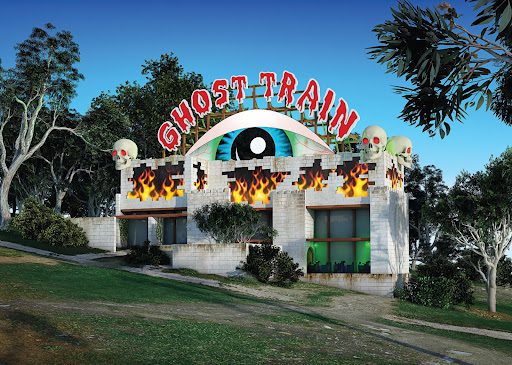Text by Emily Bour
“This isn’t the right place, why are we at a funeral home?” To have driven the 30 minutes to go to visit Callum Morton: In Memoriam at the iconic Heide Museum of Modern Art, I must admit slight frustration when confronted with the imposing ‘Le Pine Funerals’ sign at our arrival. This was, of course, our first taste of Melbourne artist, Morton’s, part site-specific project, part mid-career survey show. Drawing upon almost 20 years of Morton’s work, and also presenting a number of exciting new projects, including Monument #25: Vortex, a glass-fronted shop constructed by the artist onsite, In Memoriam certainly lives up to expectation.
The less than welcoming mock replica sculpture In the Pines (2008) is a work that must be taken with a pinch of salt. Drawing on the history of the affectionately termed Heide, Morton plays with the idea of the historical sight as a “tragic and haunted place, or a repository for a series of ghost stories.” Humour is an appropriate drawcard here, especially when many of the works (including installations, scaled models and photographic prints), quite literally, re-construct a heavy architecture of our past.
The forty-five year old, Canadian-born and Melbourne-raised Morton is the son of an architect. His works reflect a thorough understanding of built space, evidenced by the accuracy and immaculate constructions of his models. Nestled in one of the darkened rooms separated by custom built walls copying the architecture of the Heide II, we find International Style (2009). We see a model replica of the famous Farnsworth House by modernist giant, Mies Van Der Rohe, and signs of a party are clear. A soundtrack of chatter and music, and the sight of colourful lights behind the drawn curtains of a house so renowned for its transparency of living point to this, until the sound of a gunshot is heard, followed by screams. The injection of narrative here is mirrored in a smaller, more primitive maquette of a shack by Le Corbusier. Cabanon and on and on (2002-3) depicts the home where the architect passed away from a heart attack. When peering into the cut-out house, the significant architect’s personal history is referenced by a seductive plasma globe which alights with the sound of a quickening heartbeat, until it flatlines and all goes dark.
Morton’s work often requires the visitor to look twice In contrast to the immaculate models elsewhere in the show, I’m thrown by Monument #26: Settlement (2010). A crudely constructed cardboard box, covered with vivid tarpaulin that is all held together with orange string and tape – an aesthetic that seems out of place. The placard for the work lists materials of; epoxy resin and polystyrene, all anomalies considering its appearance. But of course, it is a counterfeit. With the same awe normally reserved for copied luxury brands, you can’t help but go back to it, and admire the paint job.
This kind of double-take is less apparent in what seems like the more decorative, and therefore collectable, Screens series, which Morton has developed over the years. A gallery goer fittingly points to one of the mirrored screens with cut-outs, and states that this room is her favourite, because she can see her reflection and a photo here would look good on her Facebook profile. Of course I have to laugh, but really, it is admirable that Morton’s work reaches out to such a diverse audience; one that would be willing to travel for the art.
This kind of radical individualism, so definitive of our contemporaneity, stands in sharp contrast to the ideological optimism of post-war modernism in architecture. New materials and processes conjoined to the idea that design could change the world for the better. Government constructed public housing represented an attempt at improving social welfare, ideals that Morton says he is “reconditioning” rather than abusing.
It may not be abuse, but it’s definitely calling out a message for change, somewhat like the soundtrack attached to the 1:34 scale replica commissioned apartment, Gas and Fuel (2010) where a child begs: “Help me, help me.”
Callum Morton: In Memoriam, continues until 16 October.
heide.com.au
Aesthetica Magazine
We hope you enjoy reading the Aesthetica Blog, if you want to explore more of the best in contemporary arts and culture you should read us in print too. You can buy it today by calling +44(0)1904 479 168. Even better, subscribe to Aesthetica and save 20%. Go on, enjoy!
Image:
Courtesy of the artist, Anna Schwartz Gallery, Melbourne, and Roslyn Oxley9 Gallery, Sydney.





